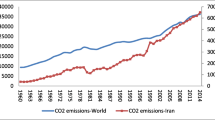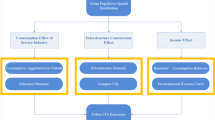Abstract
In-depth analyses of the spatial heterogeneity in environmental emissions and the causes of differences are of great importance to provide a reference for reduction policies. However, a spatial analysis of the specific mechanisms of China’s environmental emissions is rarely scarce. Using the province-level data of 30 provinces in China over 2005–2017, this paper constructs a spatial Durbin model (SDM) to empirically address the existence and spatial mechanisms of environmental emissions. The results show that: first, China’s environmental emissions show significant characteristics of spatial dependence and clustering from global and local perspectives, indicating the existence of spatial autocorrelation in environmental emissions across regions. Second, both per capita GDP and urbanization have positive impacts on environmental emissions, but the impact of environmental regulation is not significant. Third, urbanization not only directly influences environmental emissions, but also indirectly influences environmental emissions. These analyses provide comprehensive policy implications for government and policymakers to promote environmental quality.



Similar content being viewed by others
Data availability
The datasets utilized and/or investigated during the current research are available from the corresponding author on reasonable request.
References
Anselin L (1988) Spatial econometrics: methods and models. Kluwer Academic, Dordrecht
Apergis N (2016) Environmental Kuznets curves: new evidence on both panel and country-level CO2 emissions. Energy Econ 54:263–271
Bae JH (2018) Impacts of income inequality on CO2 emission under different climate change mitigation policies. Korean Econ Rev 34:187–211
BP (2019) Statistical review of world energy 2019.
Cao Y, Zhao YH, Wang HX, Li H, Wang S, Liu Y, Shi QL, Zhang YF (2019) Driving forces of national and regional carbon intensity changes in China: temporal and spatial multiplicative structural decomposition analysis. J Clean Prod 213:1380–1410
Chen Y, Wang Z, Zhong Z (2019) CO2 emissions, economic growth, renewable and nonrenewable energy production and foreign trade in China. Renew Energy 131:208–216
Cheng Z, Li L, Liu J (2017) Identifying the spatial effects and driving factors of urban PM2.5 pollution in China. Ecol Indic 82:61–75
Elhorst JP (2010) Applied spatial econometrics: raising the bar. Spat Econ Anal 5(1):9–28
Grossman GM, Krueger AB (1995) Economic growth and the environment. Q J Econ 110:353–377
Guo S, Lu J (2019) Jurisdictional air pollution regulation in China: a tragedy of the regulatory anti-commons. J Clean Prod 212:1054–1061
LeSage JP, Pace RK (2009) Introduction to spatial econometrics (statistics, textbooks and monographs). CRC Press, Boca Raton
Li K, Lin B (2014) The nonlinear impacts of industrial structure on China’s energy intensity. Energy 69:258–265
Li T, Wang Y, Zhao D (2016) Environmental Kuznets curve in China: new evidence from dynamic panel analysis. Energy Policy 91(2):138–147
Li YW, Wu HT, Shen KY, Hao Y, Zhang PF (2020) Is environmental pressure distributed equally in China? Empirical evidence from provincial and industrial panel data analysis. Sci Total Environ 718: 137363.
Liu K, Lin BQ (2019) Research on influencing factors of environmental pollution in China: a spatial econometric analysis. J Clean Prod 206:356–364
Maddison D (2006) Environmental Kuznets curves: a spatial econometric approach. J Environ Econ Manag 51(2):218–230
Mikayilov JI, Galeotti M, Hasanov FJ (2018) The impact of economic growth on CO2 emissions in Azerbaijan. J Clean Prod 197:1558–1572
Nie YY, Cheng DD, Liu K (2020) The effectiveness of environmental authoritarianism: evidence from China’s administrative inquiry for environmental protection. Energy Econ 88: 104777.
Stern DI, Common MS, Barbier EB (1996) Economic growth and environmental degradation: the environmental Kuznets curve and sustainable development. World Dev 24(7):1151–1160
Stern DI (2004) The rise and fall of the environmental Kuznets curve. World Dev 32(8):1419–1439
Sun P, Wu YM, Bao SM, Zhong YJ (2019) The interaction between economic agglomeration and environmental pollution and spatial spillover. China Ind Econ 6:70–82
Tobler WR (1970) A computer movie simulating urban growth in the Detroit region. Econ Geogr 46(Suppl. 1):234–240
Wang XT, Luo Y (2020) Has technological innovation capability addressed environmental pollution from the dual perspective of FDI quantity and quality? Evidence from China. J Clean Prod 258:120941.
Withagen C (1994) Pollution and exhaustibility of fossil fuels. Resour Energy Econ 16:235–242
**a X, Zhang A, Liang S, Qi Q, Jiang L, Ye Y (2017) The association between air pollution and population health risk for respiratory infection: a case study of Shenzhen, China. Int J Environ Res Public Health 14(9):950–961
**e Q, Xu X, Liu X (2019) Is there an EKC between economic growth and smog pollution in China? New evidence from semiparametric spatial autoregressive models. J Clean Prod 220:873–883
**n DL, Zhang YY (2020) Threshold effect of OFDI on China’s provincial environmental pollution. J Clean Prod 258: 120608.
Xu SC, Miao YM, Gao C, Long RY, Chen H, Zhao B, Wang SX (2019) Regional differences in impacts of economic growth and urbanization on air pollutants in China based on provincial panel estimation. J Clean Prod 208:340–352
Yang G, Zha D, Wang X, Chen Q (2020) Exploring the nonlinear association between environmental regulation and carbon intensity in China: the mediating effect of green technology. Ecological Indicators 114:1–11
Yang Z, Fan M, Shao S, Yang L (2017) Does carbon intensity constraint policy improve industrial green production performance in China? A quasi-DID analysis. Energy Econ 68:271–282
Yi M, Wang YQ, Sheng MY, Sharp B, Zhang Y (2020) Effects of heterogeneous technological progress on haze pollution: evidence from China. Ecological Economics 169: 106533.
Yin J, Zheng M, Chen J (2015) The effects of environmental regulation and technical progress on CO2 Kuznets curve: an evidence from China. Energy Policy 77:97–108
You W, Lv Z (2018) Spillover effects of economic globalization on CO2 emissions: a spatial panel approach. Energy Econ 73:248–57
Zhang X, Wu L, Zhang R (2013) Evaluating the relationships among economic growth, energy consumption, air emissions and air environmental protection investment in China. Renew Sustain Energy Rev 18:259–270
Zhang Y, Shuai CY, Bian J, Chen X, Wu Y, Shen LY (2019) Socioeconomic factors of PM2.5 concentrations in 152 Chinese cities: decomposition analysis using LMDI. J Clean Prod 218:96–107
Zhang W, Li G, Uddin MK, Guo S (2020) Environmental regulation, foreign investment behavior, and carbon emissions for 30 provinces in China. J Clean Prod 248:1–11
Zhao D, Chen H, Li X, Ma X (2018) Air pollution and its influential factors in China’s hot spots. J Clean Prod 185:619–627
Zhao X, Liu C, Sun C, Yang M (2020) Does stringent environmental regulation lead to a carbon haven effect? Evidence from carbon-intensive industries in China. Energy Economics 86:1–10
Zhong Z, Jiang L, Zhou P (2018) Transnational transfer of carbon emissions embodied in trade: characteristics and determinants from a spatial perspective. Energy 147:858–75
Zhou Q, Yabar H, Mizunoya T, Higano Y (2016) Exploring the potential of introducing technology innovation and regulations in the energy sector in China: a regional dynamic evaluation model. J Clean Prod 112:1537–1548
Zhu WW, Wang MC, Zhang BB (2019) The effects of urbanization on concentrations in China’s Yangtze River Economic Belt: new evidence from spatial econometric analysis. J Clean Prod 239: 118065.
Zhu YF, Wang ZL, Yang J, Zhu LL (2020) Does renewable energy technological innovation control China’s air pollution? A spatial analysis. J Clean Prod 250: 119515.
Funding
The article was supported by the National Natural Science Foundation of China (71834003).
Author information
Authors and Affiliations
Contributions
**ng Wang: formal analysis, software, data curation, visualization, and writing—original draft. Dequn Zhou: funding acquisition, validation, and writing—review and editing.
Corresponding authors
Ethics declarations
Ethics approval and consent to participate
Not applicable.
Consent for publication
Not applicable.
Competing interests
The authors declare no competing interests.
Additional information
Responsible Editor: Roula Inglesi-Lotz
Publisher's note
Springer Nature remains neutral with regard to jurisdictional claims in published maps and institutional affiliations.
Rights and permissions
About this article
Cite this article
Wang, X., Zhou, D. Analyzing China’s provincial environmental emissions and its influencing factors: a spatial analysis. Environ Sci Pollut Res 29, 20784–20794 (2022). https://doi.org/10.1007/s11356-021-17203-0
Received:
Accepted:
Published:
Issue Date:
DOI: https://doi.org/10.1007/s11356-021-17203-0




